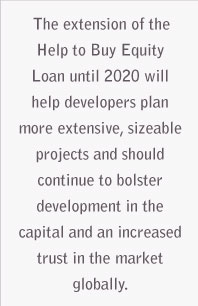The recently announced UK budget for 2014 will bring about a few changes for the property market, some welcome, some not. The extension of the Help to Buy Equity Loan until 2020 will help developers plan more extensive, sizeable projects and should continue to bolster development in the capital and an increased trust in the market globally.
 Following the introduction, in 2012, of a 15% Stamp Duty Land Tax (STDL) on purchases of £2m+ properties by a company, the government is continuing to discourage the ownership of residential property by companies. The £2m+ threshold has now been lowered to include any properties valued over £500k. Companies seeking to purchase property in this new bracket from 20 March 2014 onwards, will have to pay the 15% STDL, unless they are property investors or developers.
Following the introduction, in 2012, of a 15% Stamp Duty Land Tax (STDL) on purchases of £2m+ properties by a company, the government is continuing to discourage the ownership of residential property by companies. The £2m+ threshold has now been lowered to include any properties valued over £500k. Companies seeking to purchase property in this new bracket from 20 March 2014 onwards, will have to pay the 15% STDL, unless they are property investors or developers.
The second item to affect the property market is the extension of the Annual Tax on Enveloped Dwellings (ATED), also introduced in 2012, to properties over £500k owned by a company. There are now two new bands: one for properties valued between £500k and £1m, and a second for properties valued between £1m and £2m. The ATED rates for these bands are £3,500 (commencing April 2016) and £7,000 (commencing April 2015) respectively.
In addition to these changes, it was also announced that as from April 2015, non-residents will have to pay a UK Capital Gains Tax (CGT) when selling any residential properties in the UK. This brings the UK in line with many other countries in this regard. The tax only applies to future gains, but will apply to all residential properties, whether buy-to-lets or owner-occupied properties. The CGT does not affect commercial properties. A consultation paper providing more detailed information was published on 28 March 2014.
With regards to interest rates, the Bank of England announced in its latest inflation report in February, that interest rates are unlikely to ever reach the pre-2007 levels of 5%, even after full economic recovery is achieved. Interest rates have now been at 0.5% for the past five years and although house prices are rising at a much faster rate in central London, the Bank does not believe this is indicative of a nationwide housing bubble. It is believed that the economy has enough spare capacity to keep inflation low and interest rates need to remain low in order to keep the economic recovery on track. The extension of the Help to Buy scheme to 2020, should also bolster supply and ease the pressure on prices. However, even when interest rates do rise, the ‘new normal’ is more likely to be around 2% to 3%; substantially lower than pre-recession levels. It is expected interest rates will begin a gradual rise to this ‘new’ level by mid-2015, once capacity levels have returned to normal and inflation is close to the Bank’s target of 2%.
- Mishcon de Reya Law Firm, The Budget Briefing, 2014;
- This is Money.co.uk, Interest rates will ‘probably never’ get near to 5% again, says Bank of England as it predicts economy to boom 3.4% this year, by Matt West, 12 February 2014;
- This is Money.co.uk, When will interest rates rise? Inflation takes a tumble down to 1.7% and could keep base rate on the floor for another year, by Simon Lambert, 25 March 2014.
Past issues
- Spring 2014
- Summer 2014
- Autumn 2014
- Winter 2015
- Spring 2015
- Autumn 2015
- Winter 2016
- Spring 2016
- Summer 2016
- Autumn 2016
- Winter 2017
- Spring 2017
- Summer 2017
- Autumn 2017
- Winter 2018
- Spring 2018
- Summer 2018
- Autumn 2018
- Winter 2019
- Spring 2019
- Summer 2019
- Autumn 2019
- Winter 2020
- Summer 2020
- Autumn 2022
- Winter 2023
- Spring 2023
